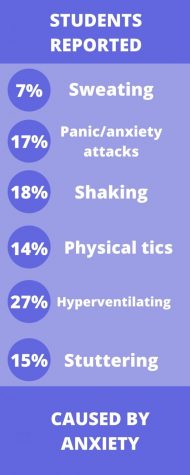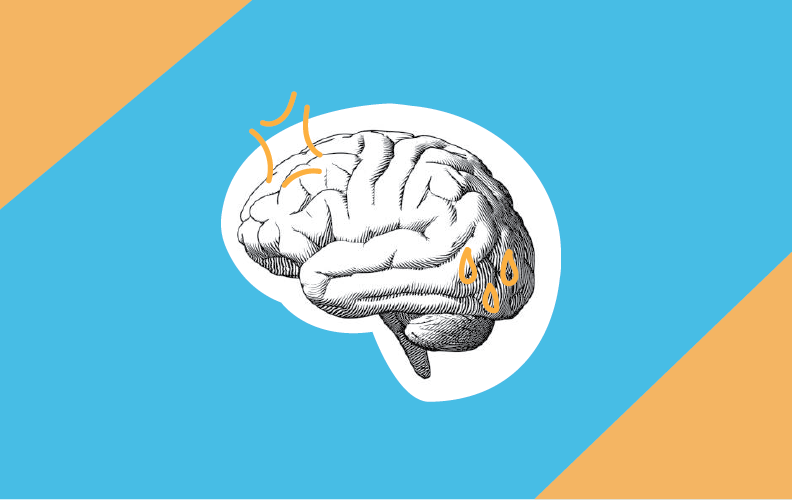Students with anxiety brace for an in-person return
March 10, 2021
While the return to in-person school is an exciting time for the Manual community, many students that struggle with anxiety are terrified for what the shift to seeing their classmates everyday and change of routine will mean for their mental health. After a year of becoming acclimated to social isolation and online school, students with anxiety fear that returning will not only increase their anxiety symptoms, but that they will affect their performance at school.
“Being in the anxiety-inducing environment of school will definitely be difficult, especially since it’s so sudden in the school year,” Lily Wobbe (11, J&C) said. “Instead of focusing on school, I’ll be anxious most of the time and it will be hard to concentrate.”
According to the Prevention Technology Transfer Center Network, lack of knowledge and education about anxiety in schools causes a stigma surrounding it, making the reality of students with anxiety a topic that is rarely talked about or known.
“My anxiety makes me want to avoid things that trigger it, so I’m a pretty big procrastinator,” CJ Mason (11, VA) said. “Being in constant flight or fight mode also makes it really hard to focus in general. I’m constantly thinking about whatI have to do next, how I might make a mistake, what people might say or think of me, etcetera.”

For many, anxiety can become unbearable, and present physical and psychological symptoms that affect their day-to-day function.
“I start shaking, my mouth gets dry, I get nauseous, and my heart pounds so hard I can’t hear anything else [when I’m experiencing anxiety],” Mason said. “It’s hard to focus on doing a breakout room or a critique on your artwork when your body thinks it’s dying.”
Students worry that these symptoms will only worsen when it comes time to walk into the school building.
Along with the more commonly known symptoms of anxiety, there are many others that may be mistaken as other problems, such as stuttering and inability to make eye contact.
“I have visual and audible tics induced by my anxiety which include flexing of the neck muscles, constant scratching of the collarbone, and a croaking of the throat,” Braden Duncan (12, MST) said. “These tics are always a part of me, but I’m sure they will persist through this change.”
Students like Juliette Cabral (12, YPAS) are already planning ahead for the anxiety they will experience during this shift to in-person learning.
“I will probably suffer from a large lack of concentration and irritability because of the stress,” Cabral said. “I will have trouble speaking out in classes, and being suddenly surrounded by a lot of people again in the small classrooms could possibly cause me to have a panic attack, but I don’t know for sure how bad it will be until we actually get back.”
Some students opted out of in-person school due to their overwhelming anxiety surrounding returning, and found that virtual schooling works much better for them in their current situations.
“Yes, [anxiety factors into my decision to stay online] completely. Not only am I anxious about getting and spreading COVID, but in-person school itself increases my anxiety,” Jaylen Mills (10, HSU) said. “I personally have multiple types of anxiety and they all come into play when it comes to being around a lot of people, answering questions in class, stressing about homework, etcetera.”
This anxiety makes virtual school the obvious choice for Mills.
“NTI has helped me worry less about a lot of those things and helped me be more comfortable with school, despite the negatives that came with it,” she said.
Although NTI works best for her anxiety, Mills does worry about some of the changes that will be made to virtual school when it comes time for most students to start school in-person.
“I’m worried that my teachers and classes will change, or that things will be a lot different because many people are saying that some teachers can’t teach both in-person and virtual. This could lead to a lot of changes for the students that stay virtual,” she said.
With this increase of anxiety in students that are returning, many believe that Manual teachers and administration should recognize students that are struggling, and accommodate to assure that students will have a successful transition back to in-person education.
“I hope teachers realize that it’ll be a difficult transition for a lot of us, but since we haven’t really been able to connect much with our teachers, I think it will be hard to communicate what we’re dealing with,” Wobbe said. “I’m nervous that teachers won’t realize the stress and anxiety on the students’ end, and we won’t be able to communicate how we really feel, so they’ll just keep assigning work and things won’t get better.”
While the goal is furthering anxiety education and accommodations, some students believe that teachers won’t take students’ anxiety seriously.
“Anytime students don’t answer questions in classes, most teachers just think of us as lazy or that we don’t know the answer,” Cabral said. “I feel with the transition back to in-person that everyone will be consumed with worrying about physical health that they won’t think about the mental health impact this transition will bring.”
“Teachers should give options that rely less on social aspects and be flexible with the needs of anxious people,” Mason said. “For example, I’ve had a teacher in the past give the option to record presentations at home and then show the video to the class. Simple stuff like that can prevent a lot of pain.”
Overall, students hope that teachers and the Manual administration will recognize this problem that, according to a poll taken on Manual RedEye’s Instagram, affects 86% of students.
“I just think the biggest thing is awareness,” Cabral said. “Just being aware that kids may be struggling rather than always assuming things like they’re lazy. Give them some benefit of the doubt.”
“A lot of students these days are saying that they want to go back to school so they can have a ‘normal high school experience,’ like going to prom, football games, school dances, stuff like that,” Wobbe said. “But for a lot of kids, that ‘normal high school experience’ is being anxious nonstop, stressing over every little assignment and setting unreasonably high standards for themselves.”
With the transition back to in-person school, students with anxiety are bracing for the impacts of increased anxiety symptoms ranging from sweaty palms and stutters to physical tics and panic attacks. While conversations about anxiety are muffled due to the stigma that surrounds it, when returning to school after over a year of NTI, it is important for teachers, administration and classmates to recognize the struggles of students with anxiety, and support them in any way they can without judgement.
“Focusing on awareness and education would be beneficial,” Mason said. “A day to talk about anxiety like we do with suicide prevention or expanding suicide prevention to be about more aspects of mental health would be nice.”
A solution could be as simple as this education.
“Things like anxiety, and neurodiversity in general, could be talked about in a class setting to give us a better understanding of one another and how not everyone’s brain works the same,” Mason said.








